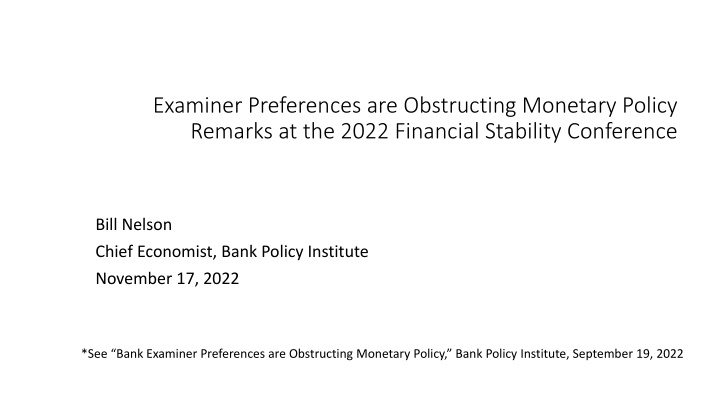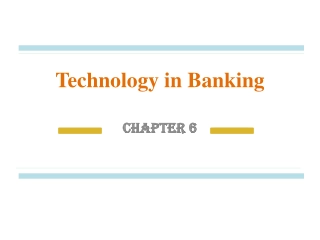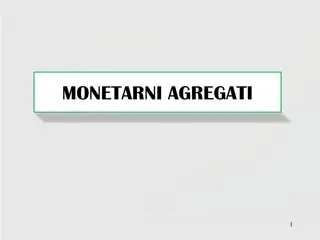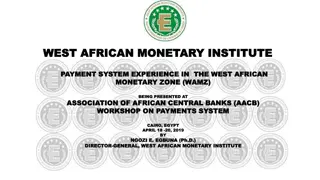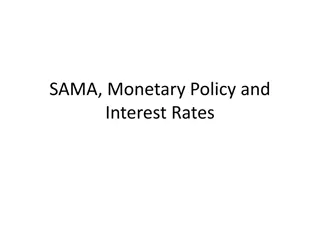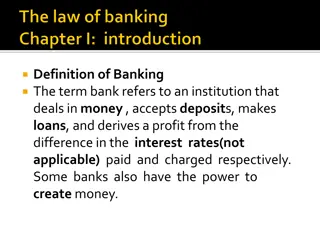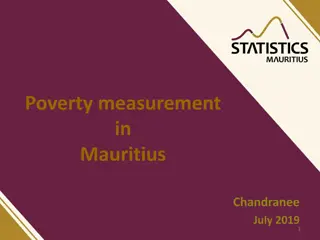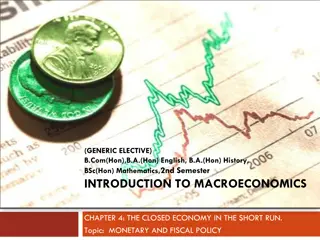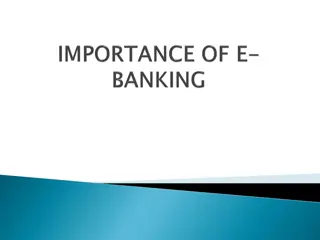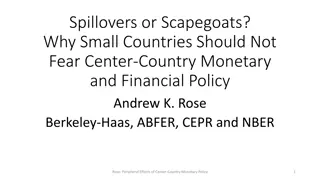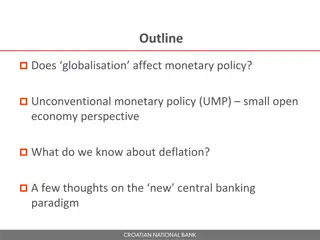Examiner Preferences in Monetary Policy and Banking
The 2022 Financial Stability Conference discussed how examiner preferences impact monetary policy, focusing on the role of reserve balances in the banking system. Banks hold high levels of reserves to avoid borrowing from the Fed, influenced by supervisory pressures favoring reserves over other assets. Examining the dynamics between reserves, liquidity requirements, and Federal Reserve policies sheds light on the complexities shaping financial stability and policy implementation.
Download Presentation

Please find below an Image/Link to download the presentation.
The content on the website is provided AS IS for your information and personal use only. It may not be sold, licensed, or shared on other websites without obtaining consent from the author.If you encounter any issues during the download, it is possible that the publisher has removed the file from their server.
You are allowed to download the files provided on this website for personal or commercial use, subject to the condition that they are used lawfully. All files are the property of their respective owners.
The content on the website is provided AS IS for your information and personal use only. It may not be sold, licensed, or shared on other websites without obtaining consent from the author.
E N D
Presentation Transcript
Examiner Preferences are Obstructing Monetary Policy Remarks at the 2022 Financial Stability Conference Bill Nelson Chief Economist, Bank Policy Institute November 17, 2022 *See Bank Examiner Preferences are Obstructing Monetary Policy, Bank Policy Institute, September 19, 2022
The Fed can get no smaller than the size The Fed can get no smaller than the size necessary to meet reserve demand necessary to meet reserve demand After reaching 36 percent of GDP, the Fed is shrinking its portfolio of assets by up to $95 billion a month. Returns the Fed to its traditional background position in financial system. Reduces interest rate risk by increasing share of portfolio funded by currency. Positions Fed to expand again if necessary. Simplified Federal Reserve Balance Sheet Loans Repo Reserves (DI Deposits) Reverse Repos Treasury Securities and Agency MBS Currency Treasury Deposit As its assets shrink, its liabilities shrink too, in particular, reserve balances (deposits of depository institutions). If reserve balances fall below the level banks demand, the fed funds rate will rise above the FOMC s target range.
Examiners understandably prefer reserves to Examiners understandably prefer reserves to other assets for liquidity purposes. other assets for liquidity purposes. Andolfatto and Ihrig (2019) Internal liquidity stress tests apparently assume a significant discount on Treasury securities liquidated in large volumes during times of stress, so that Treasuries are not treated as cash equivalent. We have heard that banks occasionally feel under supervisory pressure to satisfy their HQLA requirements with reserves rather than Treasuries. Quarles (2022) I do think that one of the drivers of that disruption in 2019 was our, not so much liquidity regulation, but liquidity supervisory policy, which put a pretty heavy thumb on the side of the scale of preferring reserves over Treasury securities in satisfying your liquidity obligations.
Banks hold high levels of reserve balances to avoid ever Banks hold high levels of reserve balances to avoid ever having to borrow from the Fed, in part because of having to borrow from the Fed, in part because of examiner preferences examiner preferences Discount window Although official Fed policy encourages banks to see DW as a viable and reliable source of backup liquidity, bank examiners view discount window borrowing negatively. Collateralized daylight overdrafts Although Fed policy is designed to encourage banks use collateralized daylight overdrafts, such overdrafts are now rare and viewed negatively. Standing Repo Facility The Fed created the SRF in part to avoid stigma of discount window, but, reportedly, examiners view it like the discount window and few banks have signed up. The Fed has issued no public guidance on use.
The standard model of demand for reserves The standard model of demand for reserves provides poor intuition for current circumstances provides poor intuition for current circumstances The model was developed to describe the behavior of the intraday fed funds rate at a time when the interest rate on reserves was zero. In current circumstances, there is no immutable level beyond which the demand curve flattens out at the IORB rate. Banks adjust their balance sheets, and examiners adjust their expectations, and reversing that process takes time and market incentives.
Recent research has shed more light on how Recent research has shed more light on how and why reserve demand has grown and why reserve demand has grown Afonso, La Spada, Williams (2022) Acharya, Chauhan, Rajan, Steffen (2022) The supply of reserves creates its own additional demand via these new claims that can come due in times of aggregate stress. the wrong way to think about QE: taking the nature of claims on liquidity on the banking sector as given and unaffected by reserve expansion. In contrast banks write new liquidity claims when exogenously pumped full of reserves, and don t shrink these claims easily.
The Feds estimate of the steep part of the The Fed s estimate of the steep part of the reserve demand curve has grown over time reserve demand curve has grown over time Fed s estimate of banks structural demand for reserve balances Date Level April 2008 March 2016 March 2018 September 2019 May 2022 $35 billion $100 billion $600 billion $1.3 trillion $2.3 trillion
Bank of England has a better QT plan Bank of England has a better QT plan The Fed does not know the structural demand for reserve balances but plans to shrink portfolio until it is about $300 billion above it. Money market rates will be below the IORB rate, no incentive for banks to economize on reserve balances. BoE plans on shrinking until borrowing at its new standing repo facility picks up. Money market rates will be a bit above the rate the BoE pays on reserves, creating an incentive for banks to reduce demand further. Increased borrowing should help limit stigma. BoE has communicated that regulators, bank boards, and overseas regulators should view borrowing at the repo facility as routine participation in money markets.
